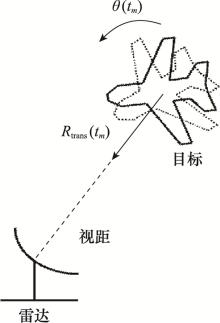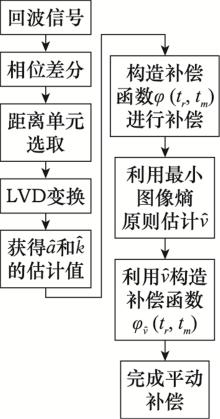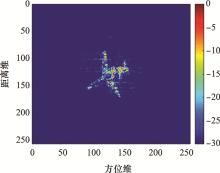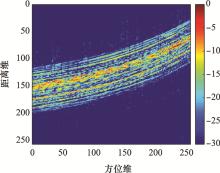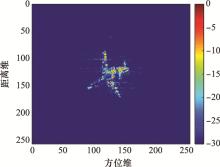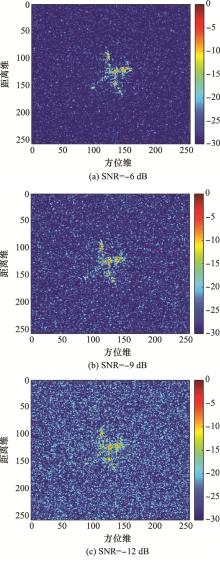Systems Engineering and Electronics ›› 2022, Vol. 44 ›› Issue (4): 1166-1173.doi: 10.12305/j.issn.1001-506X.2022.04.12
• Sensors and Signal Processing • Previous Articles Next Articles
Parametric translational compensation method for maneuvering target based on Lv's distribution
Fengkai LIU1, Darong HUANG1,*, Xinrong GUO2, Cunqian FENG1
- 1. Air and Missle Defense College, Air Force Engineering University, Xi'an 710051, China
2. Department of Basic Course, Engineering University of Chinese Armed Police Force, Xi'an, 710086, China
-
Received:2020-12-01Online:2022-04-01Published:2022-04-01 -
Contact:Darong HUANG
CLC Number:
Cite this article
Fengkai LIU, Darong HUANG, Xinrong GUO, Cunqian FENG. Parametric translational compensation method for maneuvering target based on Lv's distribution[J]. Systems Engineering and Electronics, 2022, 44(4): 1166-1173.
share this article
| 1 | 保铮, 邢孟道, 王彤. 雷达成像技术[M]. 北京: 电子工业出版社, 2005: 24- 30. |
| BAO Z , XING M D , WANG T . Radar imaging technology[M]. Beijing: Publishing House of Electronics Industry, 2005: 24- 30. | |
| 2 |
WU H Q , DELISLEG D , FANG D G . Translational motion compensation in ISAR image processing[J]. IEEE Trans.on Image Processing, 1995, 4 (11): 1561- 1571.
doi: 10.1109/83.469937 |
| 3 | WU W Z , HU P J , XU S Y , et al. Image registration for InISAR based on joint translational motion compensation[J]. IET Radar, Sonar & Navigation, 2017, 11 (10): 1597- 1603. |
| 4 |
DENIZ U , ABDURRAHIM T . Translational motion compensation for ISAR images through a multicriteria decision using surrogate-based optimization[J]. IEEE Trans.on Geoscience and Remote Sensing, 2020, 58 (6): 4365- 4374.
doi: 10.1109/TGRS.2019.2963383 |
| 5 |
LV Q , SU T , HE X H . An ISAR imaging algorithm for nonuniformly rotating targets with low SNR based on modified bilinear parameter estimation of cubic phase signal[J]. IEEE Trans.on Aerospace and Electronic Systems, 2018, 54 (6): 3108- 3124.
doi: 10.1109/TAES.2018.2845138 |
| 6 |
LEI Z . Quadratic frequency modulation signals parameter estimation based on product high order ambiguity function-modified integrated cubic phasefunction[J]. Information, 2019, 10 (4): 140- 149.
doi: 10.3390/info10040140 |
| 7 |
ZHENG J B , SU T , ZHU W , et al. ISAR imaging of nonuniformly rotating target based on a fast parameter estimation algorithm of cubic phase signal[J]. IEEE Trans.on Geoscience and Remote Sensing, 2015, 53 (9): 4727- 4740.
doi: 10.1109/TGRS.2015.2408350 |
| 8 |
LI X L , CUI G L , KONG L G . Fast non-searching method for maneuvering target detection and motion parameters estimation[J]. IEEE Trans.on Signal Processing, 2016, 64 (9): 2232- 2244.
doi: 10.1109/TSP.2016.2515066 |
| 9 | HUANG R , ZHANG L , XING M D . Doppler ambiguity removal and ISAR imaging of group targets with sparse decomposition[J]. IET Radar, Sonar & Navigation, 2016, 10 (9): 1711- 1719. |
| 10 |
HE X Y , TONG N N , HU X W . Dynamic ISAR imaging of maneuvering targets based on sparse matrix recovery[J]. Signal Processing, 2017, 134, 123- 129.
doi: 10.1016/j.sigpro.2016.12.002 |
| 11 |
KANG M S , LEE S J , LEE S H . ISAR imaging of high-speed maneuvering target using gapped stepped-frequency waveform and compressive sensing[J]. IEEE Trans.on Image Processing, 2017, 26 (10): 5043- 5056.
doi: 10.1109/TIP.2017.2728182 |
| 12 | HU X W , TONG N N , ZHANG Y S . MIMO radar imaging with nonorthogonal waveforms based on joint-block sparse recovery[J]. IEEE Trans.on Geoscience and Remote Sensing, 2018, 56 (10): 5985- 5996. |
| 13 | CHEN C C , ANDREWSH C . Target-motion-induced radar imaging[J]. IEEE Trans.on Aerospace and Electronic System, 1980, 16 (1): 2- 14. |
| 14 |
ZHU D Y , WANG L , YU Y S . Robust ISAR range alignment via minimizing the entropy of the average range profile[J]. IEEE Geoscience and Remote Sensing Letters, 2009, 6 (2): 204- 208.
doi: 10.1109/LGRS.2008.2010562 |
| 15 |
SAUER T , SCHROTH A . Robust range alignment algorithm via Hough transform in an ISAR imaging[J]. IEEE Trans.on Aerospace and Electronic System, 1995, 31 (3): 1173- 1177.
doi: 10.1109/7.395222 |
| 16 |
HUANG D R , FENG C Q , TONG N N . 2D spatial-variant phase errors compensation for ISAR imagery based on contrast maximization[J]. Electronics Letters, 2016, 52 (17): 1480- 1482.
doi: 10.1049/el.2016.1595 |
| 17 | HUANG D R , GUO X , ZHANG Z . Full-aperture azimuth spatial-variant autofocus based on contrast maximization for highly squinted synthetic aperture radar[J]. IEEE Trans.on Geoscience and Remote Sensing, 2019, 58 (1): 330- 347. |
| 18 |
WANG J D , ZHANG L , DU L . Noise-robust motion compensation for aerial maneuvering target ISAR imaging by parametric minimum entropy optimization[J]. IEEE Trans.on Geoscience and Remote Sensing, 2019, 57 (7): 4202- 4217.
doi: 10.1109/TGRS.2018.2890098 |
| 19 |
MARSTONT M , PLOTNICKD S . Semiparametric statistical stripmap synthetic aperture autofocusing[J]. IEEE Trans.on Geoscience and Remote Sensing, 2015, 53 (4): 2086- 2095.
doi: 10.1109/TGRS.2014.2353515 |
| 20 |
HOU Q K , FAN L J , SU S Y . Compensation of phase errors for compressed sensing based ISAR imagery using inadequate pulses[J]. Progress in Electromagnetics Research M, 2015, 41, 125- 138.
doi: 10.2528/PIERM14120402 |
| 21 |
BERIZZI F , CORSINI G . Autofocusing of inverse synthetic aperture radar images using contrast optimization[J]. IEEE Trans.on Aerospace and Electronic Systems, 1996, 32 (3): 1185- 1191.
doi: 10.1109/7.532282 |
| 22 |
LI X , LIU G S , NI J L . Autofocusing of ISAR images based on entropy minimization[J]. IEEE Trans.on Aerospace and Electronic Systems, 1999, 35 (4): 1240- 1252.
doi: 10.1109/7.805442 |
| 23 | GAO J, LI F, WANG C. ISAR motion compensation based on matching pursuit with Chebyshev polynomials under low SNR[C]// Proc. of the IEEE International Conference on Signal Processing, Communications and Computing, 2016. |
| 24 |
LIU L , ZHOU F , TAO M L . Adaptive translational motion compensation method for ISAR imaging under low SNR based on particle swarm optimization[J]. IEEE Journal of Selected Topics in Applied Earth Observations and Remote Sensing, 2015, 8 (11): 5146- 5157.
doi: 10.1109/JSTARS.2015.2491307 |
| 25 |
LI D , ZHAN M Y , LIU H Q . A robust translational motion compensation method for ISAR imaging based on Keystone transform and fractional Fourier transform under low SNR environment[J]. IEEE Trans.on Aerospace and Electronic Systems, 2017, 53 (5): 2140- 2156.
doi: 10.1109/TAES.2017.2683599 |
| 26 | ZHANG L , SHENG J L , DUAN J . Translational motion compensation for ISAR imaging under low SNR by minimum entropy[J]. EURASIP Journal on Advances in Signal Processing, 2013, 33. |
| 27 |
WANG J , KASILINGAM D . Global range alignment for ISAR[J]. IEEE Trans.on Aerospace and Electronic Systems, 2003, 39 (1): 351- 357.
doi: 10.1109/TAES.2003.1188917 |
| 28 |
李东, 赵婷, 宋伟, 等. 一种低信噪比下稳健的ISAR平动补偿方法[J]. 电子学报, 2018, 46 (9): 2049- 2056.
doi: 10.3969/j.issn.0372-2112.2018.09.001 |
|
LI D , ZHAO T , SONG W , et al. A robust translational motion compensation method for ISAR imaging under low SNR environment[J]. Acta Electronica Sinica, 2018, 46 (9): 2049- 2056.
doi: 10.3969/j.issn.0372-2112.2018.09.001 |
|
| 29 | 吕倩, 苏涛, 吴凯, 等. 利用HAF-LVD特性的复杂运动目标ISAR成像算法[J]. 西安电子科技大学学报, 2016, 43 (5): 24- 30. |
| LYU Q , SU T , WU K , et al. ISAR imaging algorithm for targets with the complex motion based on the high-order ambiguity function-Lv's distribution[J]. Journal of Xidian University, 2016, 43 (5): 24- 30. | |
| 30 |
LV X L , BI G A , WAN C R . Lv's distribution: principle, implementation, properties, and performance[J]. IEEE Trans.on Signal Processing, 2011, 59 (8): 3576- 3591.
doi: 10.1109/TSP.2011.2155651 |
| [1] | Anlin XU, Yu ZHANG, Feng ZHOU. High resolution ISAR imaging based on Beta process [J]. Systems Engineering and Electronics, 2022, 44(6): 1873-1879. |
| [2] | Dongfang XUE, Xiaoxiu ZHU, Wenhua HU, Baofeng GUO, Huiyan ZENG. Bi-ISAR imaging based on weighted l1 norm optimization algorithm [J]. Systems Engineering and Electronics, 2021, 43(4): 944-953. |
| [3] | Chu XU, Dongqiang ZHU, Ling WANG, Jie WANG. ISAR imaging using null space l1 norm minimization [J]. Systems Engineering and Electronics, 2020, 42(2): 315-321. |
| [4] | WANG Chao, YE Chunmao, WEN Shuliang. Micro-motion period estimation for targets with small LOS change in low PRF broadband radar [J]. Systems Engineering and Electronics, 2018, 40(9): 1945-1952. |
| [5] | ZHU Xiaoxiu, HU Wenhua, MA Juntao, GUO Baofeng. High resolution algorithm for ISAR imaging based on complex Bayesian compressed sensing using Laplace priors#br# [J]. Systems Engineering and Electronics, 2018, 40(12): 2689-2698. |
| [6] | FENG Junjie, ZHANG Gong. Multiple measurement vectors block sparse signal recovery ISAR imaging algorithm [J]. Systems Engineering and Electronics, 2017, 39(9): 1959-1964. |
| [7] | HUANG Yong, DUAN Rui, ZHANG Hai, YAN Guangyu. Signal synthetic method of polarized deceptive jamming for spatial micro-motion targets [J]. Systems Engineering and Electronics, 2017, 39(8): 1738-1743. |
| [8] | CHEN Rong, FENG Cunqian, HE Sisan, RAO Yi. Micro-motion features estimation method using ISAR images for ballistic targets [J]. Systems Engineering and Electronics, 2017, 39(7): 1500-1505. |
| [9] | YU Xiang, ZHU Daiyin, LI Junqiang, YUN Tao, HUANG Xiangfei. Range alignment algorithm based on the range migration trajectory for the space target ISAR [J]. Systems Engineering and Electronics, 2017, 39(4): 775-781. |
| [10] | LI Dong, ZHAN Muyang, FANG Zhiping, XIONG Han, JIANG Qingping. Parameterized wideband interference suppression for SAR imaging based on HAF [J]. Systems Engineering and Electronics, 2017, 39(3): 514-521. |
| [11] | ZHOU Fang, ZHANG Jia-jia, SUN Guang-cai, XING Meng-dao. Correction method for ionospheric contaminated phase on P-band ISAR signals [J]. Systems Engineering and Electronics, 2015, 37(7): 1519-1525. |
| [12] | LI Shao-dong, PEI Wen-jiong, YANG Jun, HU Guo-qi. OMP reconstruction algorithm via Bayesian model and its application [J]. Systems Engineering and Electronics, 2015, 37(2): 246-252. |
| [13] | JU Yan-wei, ZHANG Yan. Research on ISAR image quality evaluation [J]. Systems Engineering and Electronics, 2015, 37(2): 297-303. |
| [14] | ZHANG Kun-fan, PEI Xi-long, DANG Tong-xin, ZHANG Ya-ge. Estimating method for the rotation angle of ISAR image based on spectral envelope correlation [J]. Systems Engineering and Electronics, 2014, 36(8): 1511-1516. |
| [15] | SHENG Jia-lian,ZHANG Lei,XING Meng-dao,XU Gang,HE Li. Joint method of motion compensation and cross range scaling for inverse synthetic aperture radar imaging [J]. Systems Engineering and Electronics, 2014, 36(5): 859-865. |
| Viewed | ||||||
|
Full text |
|
|||||
|
Abstract |
|
|||||
